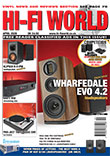Page 4 of 4
MEASURED PERFORMANCE
Measurements by Rohde&Schwarz UPV audio spectrum analyser.
The crucial EIAJ Dynamic Range value of Hugo TT2 was 124dB in DAC mode and 128dB in Amplifier mode, set to Hi gain and with volume advanced to avoid output clipping (light blue on the volume control). Both are exceptionally high values not bettered elsewhere, although ESS DACs match the figure. DesignerRob Watts insists distortion is more important than dynamic range and here the Hugo TT2 produced a record low value of 0.008% at -60dB with 24bit - see our analysis. At best rivals manage 0.02% so Hugo TT2 has half their distortion. Note that Chord Electronics only quote distortion at full scale (0dB FS) to match other manufacturers. Our -60dB test is more meaningful and now widely used. S/PDIF and USB gave identical figures. Distortion with CD (16bit) measured 0.19% at -60dB, not a lot different to usual due to quantisation noise inherent in 16bit. Dynamic range was 101dB. The S/PDIF electrical (BNC socket) and optical digital inputs (with supplied optical cable) both accepted 192kHz sample rate PCM, frequency response measuring flat to 55kHz (-1dB) with Filter 1 and 3 before slow roll off to the 96kHz upper theoretical limit, our analysis showing Filter 1. Filters 2 and 4 had a 21kHz (-1dB) upper limit – low. They are quite strong filters.. At Lo gain the headphone outputs delivered 3V max, at Hi gain 8V max. – more than enough for all headphones. Distortion an dynamic range values were identical to Line out at Hi gain, just tad lower at Lo gain. Results with M Scaler were identical although dynamic range did reach 129dB. Hugo TT2 delivers class leading measured performance in all areas. It has huge dynamic range and unusually low distortion. NK
Frequency response 5Hz-55kHz Distortion (-60dB, 24bit) 0.008% Dynamic range (EIAJ) 128dB Noise -126dB Output Hi gain (Ph/XLR) 8.5V / 17V Output Lo gain (Ph/XLR) 3V / 6V Output DAC (Ph/XLR) 2.5V / 5V Output H’phone (Lo / Hi) 3V / 8V
FREQUENCY RESPONSE
DISTORTION
|
Search
Hi-Fi World, Powered by Joomla!; Hosted by Joomla Wired.






